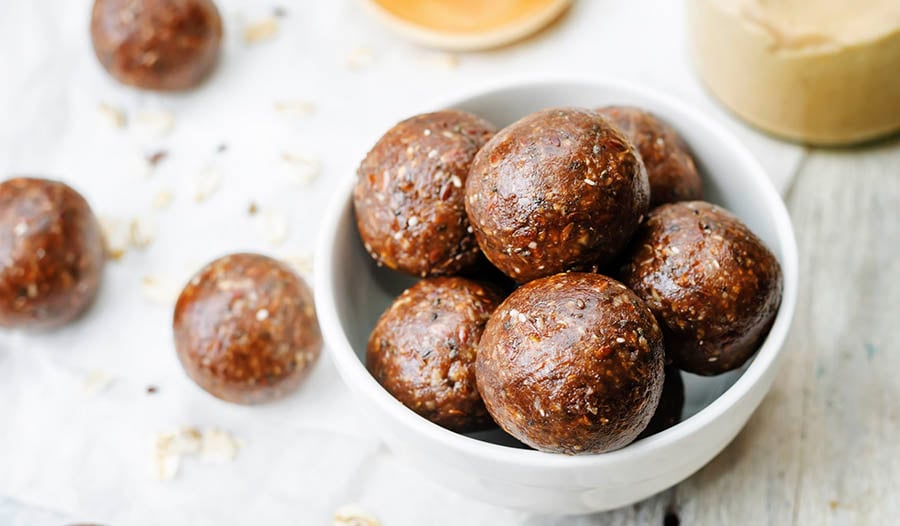Monk Fruit Sweetener: Discover the Amazing Benefits and Explore Healthy Recipes

Originally posted October 2018 / Updated July 2023
What Is Monk Fruit?
Monk fruit (Siraitia grosvenorii) is a small, green fruit native to southern China known as Luo Han Guo.
The monk fruit extract used as a sweetener is nearly 300 times sweeter than sugar and is gaining tremendous popularity as a non-caloric sweetener. But it is not a new sweetener, as monk fruit has been used in China for almost 1,000 years.
What Makes Monk Fruit So Sweet?
The sweet taste of monk fruit comes mainly from compounds known as mogrosides. These compounds typically make up about 1% of the flesh of the fresh fruit. Through extraction, a powder containing 80% mogrosides can be obtained. This monk fruit extract is the form most widely available as a sweetener.
In the United States, monk fruit extract is approved as a sweetener by the United States Food and Drug Administration (FDA) as a GRAS (generally recognized as safe) product. There are no restrictions on consuming the fruit or its extracts as a sweetener.
How Is Monk Fruit Sweetener Made?
The peel and seeds are removed from the whole fruit to make the monk fruit extract that is used as a sweetener. The fruit pulp is then pureed or concentrated by removing water and then treated with pectinase or other enzymes to break down the pectin. To improve the flavor, off-flavor compounds are first removed through either filtration, adsorption with the help of charcoal or bentonite or are precipitated with gelatin or other gelling agents. Low pressure is then used to evaporate some sulfur-containing compounds and dry the extract, which is then pasteurized to inactivate the remaining natural enzymes that can degrade the extract and kill off any microorganisms.
What Are The Health Benefits of Using Monk Fruit Sweetener?
The primary benefit of monk fruit extract is as a non-caloric sweetener to replace sugar. This benefit allows people to enjoy the added sweetness in their diet without the calories or effect on blood sugar levels. Monk fruit is beneficial for people with diabetes. It does not have an adverse effect on blood sugar control.
Evidence shows that it helps support normal blood sugar levels and metabolism by activating a key enzyme that regulates the body's energy levels, AMP-activated protein kinase (AMPK). By targeting this pathway, monk fruit extract improves the uptake of glucose into cells, where it is converted into energy. Activating AMPK also improves fat metabolism and helps burn fatty acids for energy.
In addition, the mogrosides in monk fruit extract have also shown significant biological actions in preclinical studies, including antioxidant, anti-inflammatory, brain protective, and other health-promoting effects. This indicates that using monk fruit extract as a sweetener may produce many health benefits beyond reducing calories or improving blood sugar control.
How Is Monk Fruit Sweetener Used in Cooking?
Monk fruit sweeteners can be used exactly like sugar in any recipe. Follow label instructions when determining the amount of the monk fruit sweetener equal to refined sugar. Furthermore, it will dissolve and blend just as well as sugar.
Monk fruit extract will dissolve and blend just as well as sugar. The sweetener does particularly well in recipes with a soft texture and a rich flavor. The following are a few recipes highlighting monk fruit extract's versatility. These recipes reflect a monk fruit sweetener that is a 1:1 replacement for sugar.
Flourless Raspberry and Chocolate Monk Fruit Cake Recipe
Flourless chocolate cake is a favorite recipe even for those who are not gluten-free because it has a rich, pudding-like texture. This tasty version increases the flavor even more by creating a fresh raspberry sauce on top of the cake.
Ingredients:
- 1 Tbs. coconut oil
- 12 ounces chopped bittersweet chocolate
- 12 Tbs. unsalted butter
- 1 Tbs. espresso powder
- 1/4 tsp. salt
- 6 eggs
- 1 1/2 cup monk fruit sweetener plus 2 Tbs. monk fruit sweetener
- 12 ounces frozen or fresh raspberries
Instructions:
- Preheat the oven to 325 degrees Fahrenheit. Prepare a 9-inch springform pan by wrapping the exterior with foil and oiling the interior with coconut oil.
- Place the chocolate, butter, espresso powder, and salt in a microwave-safe bowl.
- Melt the ingredients in the bowl by microwaving for 30 seconds, stirring, and repeating until melted. Set aside to cool.
- Place the eggs and monk fruit sweetener in a large mixing bowl and whip for about 10 minutes until the eggs look light yellow and thick.
- Gradually add the chocolate mixture to the egg mixture, stirring continuously.
- Put the batter in the springform pan and place in the oven.
- Cook until a toothpick inserted in the cake looks wet but not sticky. This will take 45 to 55 minutes.
- While the cake cooks, prepare a raspberry sauce by combining berries and 2 tablespoons of monk fruit sweetener in a pan over medium-high heat. Simmer it steadily until the berries break down, and the sauce is thick. This will take 10 to 15 minutes. If desired, strain seeds out of the sauce before setting aside until the cake finishes.
- Remove the cake from the oven and let it cool.
- Take the cake out of the springform pan, slice into servings, and top each slice with a spoonful of sauce.
Fudgy Monk Fruit and Almond Fat Bomb Recipe
Fat bombs are a favorite snack of people on the ketogenic diet. They combine healthy forms of fat with some tasty flavorings to create a little treat that satisfies dessert cravings without wrecking a person's diet. This recipe combines the flavors of chocolate, almond butter, and monk fruit to create something truly delicious. It is ketogenic, paleo-friendly, low-carb, vegan, and free of grain, gluten, dairy, and sugar.
Ingredients:
- 1 cup room-temperature coconut oil
- 1 cup almond butter
- 2 Tbs. monk fruit sweetener
- 1/3 cup coconut flour
- 1/2 cup cocoa powder
- 1/4 tsp. pink Himalayan salt
Instructions:
- Combine the coconut oil and almond butter and heat until melted with either a stove or a microwave.
- Stir the oil and butter together until thoroughly blended and remove from the stove.
- Mix in the monk fruit, coconut flour, cocoa powder, and salt.
- Put the mixture in the freezer for 90 minutes until a solid yet slightly moldable dough forms.
- Divide the mixture into two-tablespoon portions and roll each portion into a ball.
- Put the balls on a flat tray and freeze the balls for 15 more minutes.
- Refrigerate until ready to serve.
- Serve and enjoy.
Gluten-Free Chocolate Chip Monk Fruit Cookie Recipe
People craving chocolate chip cookies do not have to give in and eat an unhealthy cookie loaded with processed junk. A chocolate chip cookie can be a reasonably healthy treat with the right ingredients. This recipe uses a combination of almond flour, dark chocolate, and monk fruit sweetener to create delicious cookies that even those not on a diet will love.
Ingredients:
- 1/3 cup monk fruit sweetener
- 2 cups almond flour
- 1/4 tsp. Himalayan salt
- 1/2 tsp. baking soda
- 1/2 cup ghee or butter
- 1 beaten egg
- 1 Tbs. vanilla extract
- 1 cup dark chocolate chips
Instructions:
- Preheat the oven to 350 degrees Fahrenheit and line a baking tray with parchment paper.
- Combine monk fruit, almond flour, salt, and baking soda in a food processor and mix the mixture a few times.
- Add butter to the mixture and pulse until it resembles coarse crumbs.
- Transfer to a large bowl and stir in the beaten egg and vanilla until a wet dough forms.
- Fold the chocolate chips in gently.
- Roll the dough into 1-inch balls. There should be enough dough for roughly 14 to 16 cookies.
- Place dough balls on baking sheet, leaving at least 1 inch between them. Do not flatten the balls because they will flatten naturally as they bake.
- Cook until brown. This will take roughly 13 minutes.
- Allow cooling for 10 minutes.
- Store the cookies in an airtight container until ready to serve.
- Serve and enjoy.
References:
- Wu J, Jian Y, Wang H, et al. A Review of the Phytochemistry and Pharmacology of the Fruit of Siraitia grosvenorii (Swingle): A Traditional Chinese Medicinal Food. Molecules. 2022 Oct 5;27(19):6618. doi: 10.3390/molecules27196618. PMID: 36235155; PMCID: PMC9572582.
- Shivani, Thakur BK, Mallikarjun CP, et al. Introduction, adaptation and characterization of monk fruit (Siraitia grosvenorii): a non-caloric new natural sweetener. Sci Rep. 2021 Mar 18;11(1):6205.
- Liu H , Qi X , Yu K , Lu A , Lin K , Zhu J , Zhang M , Sun Z . AMPK activation is involved in hypoglycemic and hypolipidemic activities of mogroside-rich extract from Siraitia grosvenorii (Swingle) fruits on high-fat diet/streptozotocin-induced diabetic mice. Food Funct. 2019 Jan 22;10(1):151-162.
- Li H, Li R, Jiang W, Zhou L. Research progress of pharmacological effects of Siraitia grosvenorii extract. J Pharm Pharmacol. 2022 Jul 15;74(7):953-960.
DISCLAIMER:This Wellness Hub does not intend to provide diagnosis...
















































































 Table of Contents
Table of Contents


